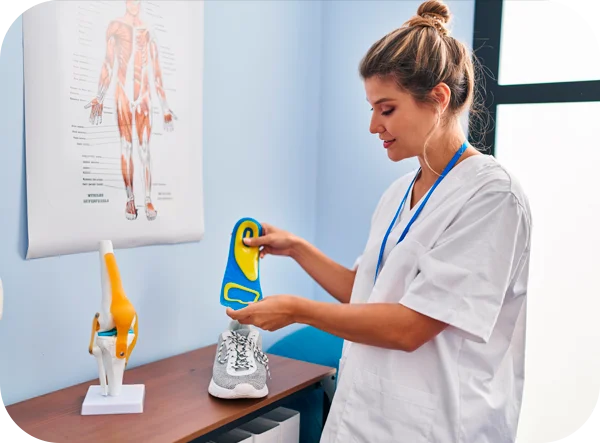Podiatrists indemnity and liability insurance
Your line of work is unique, so we’ve tailored an insurance policy that best suits the needs of your profession to better protect your reputation and livelihood.
Association Endorsed by


If you're forced to defend your professional reputation, you'll want the best support behind you.
Our policies include three types of insurance in one designed specifically for exercise professionals combining: professional indemnity insurance, public liability insurance, and product liability insurance.
Product liability
Insurance cover for liability for injury or property damage caused by goods sold or supplied by you. This can include cover for clients getting sick or injured from products you provide for example; custom made orthotics, anti-fungal sprays and more.
Extra benefits of this insurance policy
Nil basic excess on liability claims
Run-off cover which protects you when you’ve ceased practising permanently
Cover for legal costs and expenses associated with complaints to your registration body, disciplinary proceedings or a coronial inquiry
Provides a 21-day cooling-off period, allowing you to change your mind after purchasing coverage
Ongoing education through our RiskHQ, providing you with relevant and informative information on the risks that matter to you
Round-the-clock support with 24 / 7 claim support line availability
To find out more or to get your hands on our policy wording, simply call us on 1800 810 213.
FAQs
The law governs that any professional exercise the required skill to an appropriate level expected by that profession. A professional may be liable for financial loss, injury or damage arising from an act, error or omission of fault if the professional has not acted to the required level of skill deemed in that profession. Failure through this may result in the claimant (person who suffered the loss) be awarded for that loss, damage or injury.
Many professions require you to hold a professional indemnity insurance policy by law, such as Ahpra registered professions, but can be for other industries such as financial institutions also. Please check with your registration body or associations of your profession to know if it is required by law to have professional indemnity insurance. It is often also required by companies who take on contract workers that are not governed under the companies own insurance policy. It is acceptable for a company to ask you as the professional contractor to provide evidence of cover for professional indemnity before starting the contract period.
As stated above professional indemnity insurance covers you for breaches in relation to your professional duty. Liability insurance covers you for activity that results in personal injury or property damage as a result of your business activities that do not relate to your specific profession. An example may be someone who trips and is injured from spilled water within your office may be covered under liability, because it is your duty of care as business person to provide a safe environment. Whereas a person who suffers a loss or injury because of your professional treatment in relation to your job has caused it would usually be consider as an indemnity breach.
Generally business insurance is to cover the physical assets of your business for material damage loss and options for theft cover. It can also include cover for financial loss due to business interruption. Usually basic insurance does not cover breach of duty or flood cover, but if you speak to an insurance specialist it can often be added to your policy for a nominal fee.
Depending on the policy you are taking out, covers will often vary. At Guild insurance we specialise in making a policy to suit your business so that you are not over paying for covers you wouldn't normally need. The best thing to do is call 1800 810 213 to speak to an insurance specialist, they can find out what activities and structure your business is in to then provide you with adequate cover for you.
A certificate of currency (or COC for short) is a written document that confirms that your insurance policy is current and valid at a specific date and time. At Guild we provide easy access to your COC at any time within a few clicks of our online portal PolicyHub. If you are a new customer we can provide you with one post purchase.
Our partnership with Podiatry Western Australia
Guild is the principal partner of Podiatry Western Australian and has been for over 4 years.
We work closely with your association to tailor an insurance policy suited to your unique needs.
Podiatry Western Australia is the leading body for podiatrists in WA, dedicated to advancing foot health and supporting high standards in podiatric practice.
Insurance for students studying to be an exercise professional
As a student, we understand you’ve got enough to worry about between completing your studies, getting enough practice hours in and preparing yourself for working with clients. The last thing on your mind is insurance cover. But one small accident could set you back for life. And that’s why AUSactive has chosen Guild Insurance to look after your insurance needs.
Simply register with AUSactive under the Student Policy to be eligible for your cover.

Not just an insurance policy
Risk articles with RiskHQ

You can visit RiskHQ at any time to read up about the unique risks you face as an exercise professional. We cover a variety of risk management topics, from managing complaints, to social media risks, and much more.
Keeping podiatry chairs safe
Not all podiatry claims are directly related to treatment; Guild Insurance regularly receives claims for injuries arising from podiatry chairs. No one sets out to have someone injured in their care. When it happens, it can be distressing for you and your client. People come to you for help; they don’t expect to be injured. If they have a bad experience, they may never return to your practice and are likely to tell others of their misfortune.
The following cases highlight how easily incidents can happen.
Case 1
A man fell from a podiatry chair when he bent forward to remove a shoe. At the time the chair was raised to its maximum height, altering the centre of gravity. The chair tipped and the man fell from a height of approximately one metre, landing on his left shoulder. He suffered a fracture and as a result, could not work for an extended period.
Case 2
An elderly woman attempted to move off the chair as the podiatrist was lowering it down. She stumbled and fell, sustaining a laceration to her ankle. Due to a long history of diabetes and peripheral vascular disease, the wound took many months to improve.
Case 3
A client fell to the ground when the back rest of the chair suddenly gave way without warning. The man landed on his head, suffering bruising and serious lacerations.
Reducing the risk of injuries
Working with clients
- Don’t assume clients will act safely on or around the chair, it’s not uncommon for clients to behave in a way you wouldn’t expect.
- Ensure the chair is positioned at the lowest setting before clients enter the room.
- If you leave the room, instruct them not to attempt to sit on the treatment chair, or the podiatrist’s stool, until you return. Have a conventional chair available.
- Supervise people getting onto and off the chair. Instruct them not to attempt to reach out or get off the chair without your help.
- Consider how a client’s size and weight may impact the stability of the chair, particularly when the chair height is raised.
- Don’t let children play on, or under, the chair.
- Consider the benefits of using signage to further alert clients to the dangers of not following safety instructions.
- Ensure all staff have been educated about the risks of using podiatry chairs and how to use them safely.
Maintaining or purchasing treatment chairs
- Reduce clutter in and around the treatment area. Keep equipment or other objects away from the chair’s foot switch to avoid accidentally activating the pedal.
- Think about the age and suitability of your current chair(s). Is it suitable for safely treating obese or elderly clients?
- Anchor the chair to the floor, if possible.
- Adhere to the manufacturer’s instructions. Obtain another copy of the manual, if the original has been misplaced.
- Regularly clean and service the chair according to the manufacturer’s guidelines.
- When purchasing a new chair, consider the:
- maximum weight it can safely accommodate
- degree of stability the chair maintains as the height is raised, or if weight is transferred to the foot plate
- ease with which arm rests can be retracted to help clients safely get on and off the chair
- infection control risks and the ease with which it can be cleaned
- importance of securely anchoring the chair to the floor
- other safety considerations relevant to your practice
- Podiatrists
- Business
- Professional
Insurance for Podiatry and Health Centres
If you own a podiatry or health centre and need insurance for your building, contents and more. Visit our information on business insurance for podiatry businesses.

*Coverage up to $20 million requires your selection of cover up to this limit during the quote and purchase process.





Write a review Average rating: